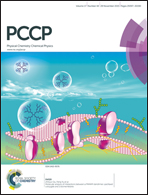A magnetooptical study of (4-(2-dibutylaminoethanolato-N,O,O,O) chlorido copper(ii)): a cubane complex with dominant ferromagnetic interactions†
Abstract
This paper reports the experimental and theoretical study of a tetranuclear (CuClOCH2CH2N(C4H9)2)4 complex. Analysis of the magnetic circular dichroism spectrum was performed based on the Hamiltonian that includes the crystal field of the nearest ligands and the spin–orbit interaction. The crystal field parameters were evaluated in the framework of the exchange charge model that accounts for the exchange and covalence effects. The values of the crystal field parameters obtained during the analysis of the magnetic circular dichroism spectrum were used for the calculation of the principal values and the directions of the principal axes of the local g-tensors and for the simulation of both temperature dependence of the magnetic susceptibility and field dependence of the magnetization. The value of the exchange parameter (Jex = 30 cm−1) was obtained. It was demonstrated that the description of the low temperature magnetic properties requires taking into account the intercluster interaction.


 Please wait while we load your content...
Please wait while we load your content...